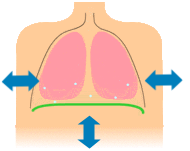Diaphragmatic yoga breathing allows one to take normal breaths while maximizing the amount of oxygen that goes into the bloodstream. In yoga, diaphragmatic breathing is different from abdominal breathing or belly breathing. Here, the main muscle for breathing is the diaphragm. In yoga diaphragmatic breathing, the movement will be only on the diaphragm muscles and middle ribs. Your upper chest and the abdomen muscles will remain normal, without much movement. Human body is designed to use the nose , lungs and diaphragm muscles for breathing, not the mouth or the abdominal muscles. Steps for yoga diaphragmatic breathing are as follows:
 Step 1: Sit on a chair. Keep your posture straight. Full contraction of the diaphragm necessitates optimal postural alignment of the thorax, the spine and the pelvis. Straight and relaxed posture is very important of full breathing.
Step 1: Sit on a chair. Keep your posture straight. Full contraction of the diaphragm necessitates optimal postural alignment of the thorax, the spine and the pelvis. Straight and relaxed posture is very important of full breathing.
Step 2: Bring your awareness around the diaphragmatic muscles and the side ribs.
Step 3: Breathe smoothly and slowly through your nose, allowing no jerkiness or irregularities to disturb the steady flow. As you inhale, diaphragm will go down and as you exhale diaphragm go up.
Step 4: Breathe with the diaphragm, allowing the ribs to slightly expand to the sides, while the shoulders, and upper chest remain almost motionless. There will be just normal movements of the abdomen. Slightly expand the bottom third of the lungs side-wise.
Step 5: For few minutes, breathe evenly, so that exhalation and inhalation are of the same duration.
Step 6: Once you are comfortable, allow the exhalation to be longer than the inhalation during the practice time.
Benefits of Diaphragmatic Breathing:
Six main benefits of diaphragmatic breathing are:
1. Diaphragmatic breathing releases endorphins throughout the body. Endorphins are feel-good, natural painkillers.
2. Diaphragmatic breathing balances the autonomic nervous system, reducing heart rate and breathing rate and changing from sympathetic fight or flight to parasympathetic calm and relax.
3. Efficient gas exchange – When we use diaphragm, we are able to access the lower parts of the lungs which are 7 times more productive in gas exchange than the upper parts of the lungs. The bottom third of the lungs is where about two thirds of the gas exchange takes place, so oxygenation is more efficient when you use the diaphragm.
4. Less tension and tightness in the neck and shoulders as the muscles here can relax.
5. Diaphragmatic breathing gently “massages” or moves the abdominal organs, aiding digestion and helping lymphatic drainage; much of the lymphatic system is located just below the diaphragm.
6. The diaphragm contributes to good posture and core muscle strength, so needs to work properly. In fact overdeveloped abs and sucking the stomach in can hinder proper movement of the diaphragm, and promote upper chest breathing.
The benefits of learning and practicing diaphragmatic breathing are immense. Instead of breathing rapidly, such as at 18 breaths per minute, by practicing yoga diaphragmatic breathing, the person learns to breathe effortlessly and slowly (about 6 to 8 breaths per minute). This slower breathing increases sympathetic-parasympathetic balances. It reduces the production of cortisol and increases melatonin levels.